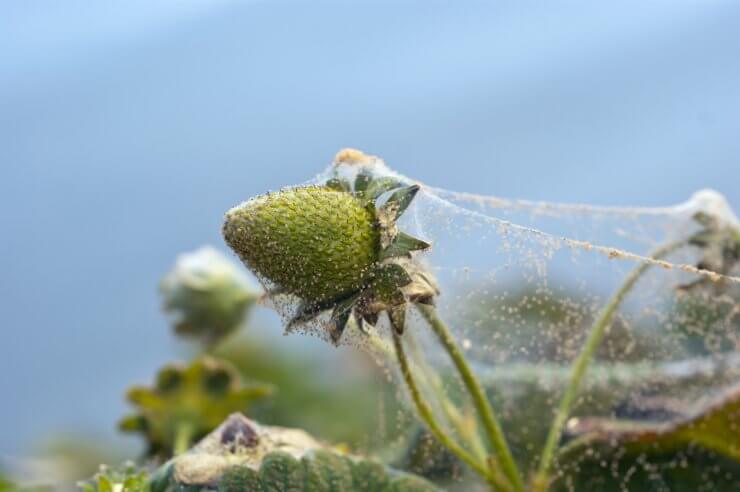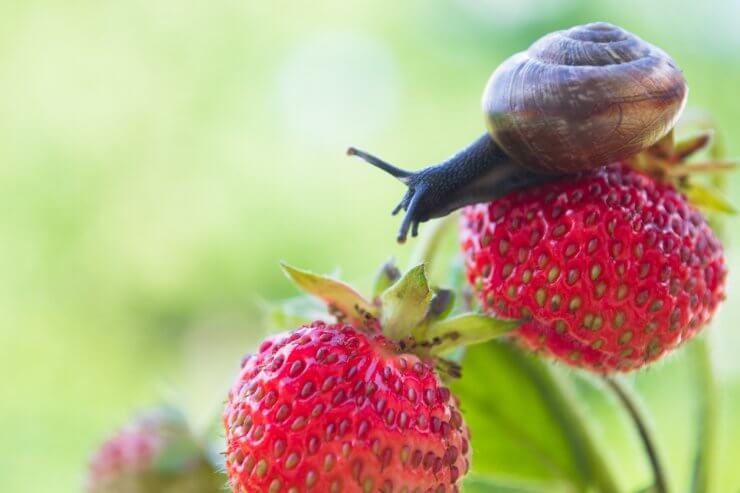
Red spider mites on a strawberry plant
Pests in your strawberry patch, left unchecked, can damage and destroy your precious strawberry plants. Keeping a close watch on your plants during regular daily inspections will help you spot any pests before they can do irreparable harm.
The easiest to spot are birds, which will surely dine on your fruit the day before you plan to harvest. Deter them with bird netting, draped over your plants and gathered at the stem or weighed down at the edges.
Smaller pests include slugs, spider mites, strawberry bud weevils, and spittlebugs. Healthy plants can handle some damage, but slugs and weevils in particular can have a big impact on harvest. Slugs eat the fruit, and weevils bore into buds to suck the pollen out.
How to deal with pests on strawberry plants

Snail eating strawberries
Here are some proven ways to get rid of pests on your strawberry plants. Choose the best treatment for the type of pests invading your plants.
- Inspect plants regularly. Look for signs of feeding and for eggs on the undersides of plants. Look for clipped buds that could mean strawberry bud weevil activity. Keep an eye out for tarnished plant bug adults when buds are green or white.
- Set out traps. Set out traps for spotted wing Drosophila or other flying pests, and baits for slugs if damage is detected.
- Pick off the pests. Use your garden gloves to remove the pests by hand. After removal, destroy pests by drowning them in a bucket of soapy water or crushing them with your foot. Handpicking isn’t efficient or practical for very small pests but works well with larger pests.
- Apply insecticidal soap. Insecticidal soap is organic. The potassium salts in insecticidal soap help remove an insect’s protective waxes, causing destruction of insect membranes and killing them. Insecticidal soaps are particularly effective on smaller pests. Mix the soap with water to create your solution and apply directly to insects on any plants. While insecticidal soap is less apt to affect other organisms, certain plants might be sensitive to the soap and can suffer leaf burn.
- Apply horticultural oils. Combine plant- or petroleum-based oils with water to produce horticultural sprays. Neem oil, for instance, is derived from seed extracts of the neem plant. Oil-based sprays block an insect’s air holes, interfere with an insect’s metabolism, disrupt insect feeding, and inhibit insect growth. Like insecticidal soaps, horticultural oils can cause plant injury if not properly diluted. This is a good remedy for weevils.
- Apply diatomaceous earth (DE). This substance on the ground around your plants will deter slugs, which don’t like to crawl over the DE.
- Pick off any damaged or non-producing buds. These are probably housing weevils.
- Harvest fruit. Pick fruit as it ripens to help protect against sap beetles and spotted wing Drosophilla. Remove and dispose of overripe fruit.
- Make your own pest spray. You can make your own pest spray with benign materials. Mix one tablespoon of baking soda, 1/2 teaspoon of a mild dish detergent, and 2 1/2 tablespoons of olive oil in a gallon of water to make a solution that will repel all kinds of bugs. Shake it well in your bottle before spraying and repeat every week for it to be continuously effective.
Do pests attack your strawberry plants every year? How do you handle removing them—and even preventing them in the first place?


 Previous
Previous


Pillbugs seem to be getting our strawberries just as they start to ripen. I tried beer on a saucer but it evaporated before I got any bugs. Any other ideas?
I have little minute white bugs or eggs on my strawberries. I’ve tried neem oil mixture, vacuuming, soaking with water bath on the leaves and can get them to go away. If I shake the leaves the sort of fall/shower off in mass. There is a sticky shiny residue on the bottom of my areogarden tray. Any suggestions. I can’t get rid of them. Once in awhile I see a tiny black dot type bug. They may be laying the white powder like ?eggs?
I have a lot of strawberries that are blooming and berries ready to ripen. Every year I have trouble with ants. I noticed yesterday as I looked at my berries that ants are camped out everywhere around my berries! I’ve tried for years to get rid of them with different products, they keep coming back! I don’t know know what to do to get rid of them. Even tired hot boiling water in their nests. What can I do to get them gone? I have a lot of berries coming on the vines and don’t want the ants to destroy them!
Nancy,
It’s so frustrating when pests ruin all your hard work.
We recently had an ant problem at my house. We’d never seen an ant inside, until our neighbors started a major construction project. I think the ants decided to migrate to my yard to escape the noise and disruption. We tried quite a few things but the final solution ended up being borax traps. There’s quite a few diy recipes online including this one: https://deepgreenpermaculture.com/2020/10/23/how-to-make-borax-ant-bait-for-indoor-and-outdoor-use/
or you could try one of the borax-based Terro products.
Good luck and happy gardening!
Are the ants actually eating the berries, and/or harning your plants? I have several kinds of ants in my yard and gardens, and there are a few that don’t seem to harm anything at all. then there’s the ones that make the big anthills, causing the roots of some of my plants to dry out, as the ants have done TOO good a job at aerating the soil underneath them! I’d say that if they aren’t actually eating/harming your strawberries, I’d leave them alone. They may be there because there is a good food source for them – pests that would actually be harming your strawberries or surrounding plants. I tend to trust nature to balance itself out – seems to be working for me. If your strawberries aren’t being harmed, consider yourself lucky – you have free pest control, in the form of ants lol! Best of luck 🙂
The last two years, we have had deer come by and eat all the tops off our strawberry plants. How can we stop them from helping themselves without building a tall fence. Last year there were only a couple, this year we have seen 6 or 7 at a time. It isn’t deer season.
Barbara,
Deer seem to be insatiable and quite determined to feast on our hard work. You might try covering your berries with some netting. It keeps out birds and deer. However, if you don’t like the look of netting or if you have an especially large bed of berries, perhaps a fishing line fence will do the trick. You’ll need 30-lb monofilament line (or stronger) and some stakes, fence posts or even trees. Wrap the line around the posts at 12 inch intervals and go as high up as you can manage. This creates a physical barrier that deer have a hard time seeing – so they don’t know how high to jump. Good luck and let us know how it works out.